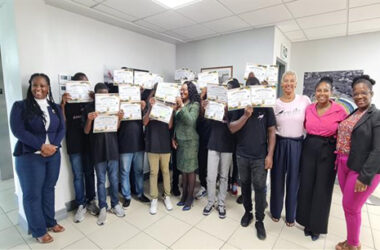With a view towards upgrading the database for the feasibility of building contractual works undertaken on the island, a training course was conducted to equip local engineering tutors and other professionals on the best practices involved in that field.
Engineers, architects and select faculty members of the Sir Arthur Lewis Community College recently participated in a Building Condition Assessment course organised by the National Integrated Planning and Programme Unit (NIPP) in the Department of Finance.
The course was geared to train participants to better assess government assets pre and post-disaster and to inform policymakers on the best use of finances in relation to a building asset.
The NIPP unit held the two-week Building Condition Assessment and Asset Management train the trainer’s Course at the Sir Arthur Lewis Community College. Director of the NIPP, Haward Well noted that training modules included best practices for maintaining public buildings through the conduct of building condition assessments, planning and prioritizing maintenance, and deriving replacement costs for financial decision-making.
“Throughout the years (for) the government of Saint Lucia, this has been a continuous problem. Buildings and their conditions. Eventually, it moves onto sick buildings. So we’re taking the scientific approach to this,” said well.
“We want to develop a series of baselines, a strategy where we can attack this at least to create a baseline. Get the data that can inform…and very importantly, our policymakers and our finance technocrats,” he added.
“So when they get submissions from all the agencies who’re responsible for taking care of government buildings, they in turn will understand the decision-making process and of course the figures that come before them.”
The training course was facilitated by Luis D. Aponte Bermúdez, Ph.D., P.E., who is a Consultant Structural and Wind Engineer and a Professor at the University of Puerto Rico. He said this course is important as it prepares future engineers and architects to perform condition assessments on buildings.
“I think the main purpose of these two weeks is to create the train the trainers and the participants are eager to learn and use this in the future especially the faculty members here at the college. They will be able to use this as a starting point and improve as needed to meet the needs of the people of Saint Lucia,” he explained.
Lecturer in the Engineering and Circular Economy Unit at the SALCC Kayreen Cenac-Hippolyte is optimistic that this asset management course will redound positively to future building infrastructure on the island.
“For our students here, I know it will definitely assist them in being more aware of the choices that we make as it pertains to buildings and our use of materials, our way of designing and our way of constructing. So students will be a lot more aware of their actions going out into the field,” she explained.
The SALCC lecturer adds that, “ In terms of preventative maintenance, in terms of being able to assess a building better and to understand all of the difficulties we have with our current building, it will assist them in that way and place them in a much better place to do better.”
Theobalds Consulting was tasked with developing a tool to assist the NIPP Unit in relation to asset management. In developing the tool, a physical assessment was conducted on 25 buildings and a report was generated outlining the condition of these buildings, the required repairs or renovations, and the high-level cost to remedy the building’s condition.
Charlene Menal is a Civil Engineer with Theobalds Consulting.
“I think the NIPP Unit is doing a very good job in terms of looking at this from a long-term perspective. Government has a lot of facilities,” declared Menal. “I think the list right now …is about 500 but we only started with 25 just to get the ball rolling and I think the intention would be for various technocrats, those in the Ministry of Planning, the Ministry of Finance as well as the component they are doing with Sir Arthur.”
She added, “So they are trying to get students trained up so that they two can help with improving that database and over time will have all these on that database with all those matrices in there.”
The information generated by the database will also inform when an asset has reached a point of being considered obsolete and ultimately provide policymakers the evidence to make better use of limited resources.





